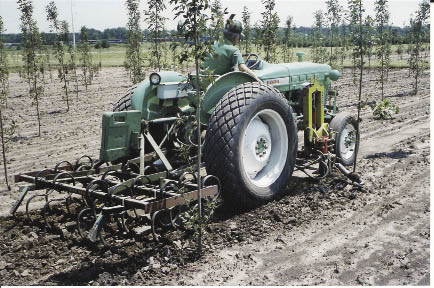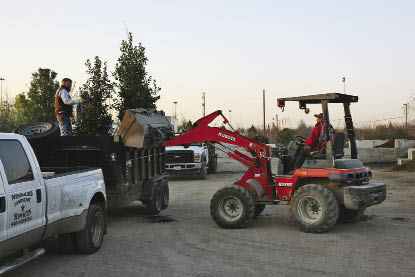Like many other specialty markets, the needs of nurseries are unique and demanding.
From tillers, tractors and skid-steers to irrigation equipment, golf carts and telehandlers, nursery growers need dependable, versatile equipment and reliable service to keep their businesses running.
The nursery industry is highly segmented and specialized. Growers in suitable climates raise the trees, bushes, shrubs and grasses needed for landscape projects. This group can be divided into container or bare-root growers, ball-and-burlap or in-ground container growers.
Growers usually sell their product to distributors, contractors or retailers, who in turn supply the end user. Some nurseries raise plant material and do the installation themselves at landscape sites, although that’s rare.
Nurseries can range from small mom-and-pop growers or distributors with a few acres to large operations like Azusa, Calif.-based Monrovia, which has 4,724 acres and locations in 4 states that supply products to more than 5,000 garden centers in the U.S.
The U.S. nursery industry had $6.5 billion in sales from 22,130 farms in 2007, according to the USDA’s 2007 Census of Agriculture. There were 20,906 outdoor farms totaling 446,496 acres in ’07, as well as 4,590 nursery operations under glass or other protection that totaled 187 million square feet.
One of the earliest pushes for growth in the nursery industry began when former First Lady Ladybird Johnson pushed for the beautification of U.S. highways, says Dwight Hughes of Hughes Nursery and Landscaping in Cedar Rapids, Iowa.
A second boost in growth occurred with the advent of Earth Day and the greater focus on addressing air and water pollution. In the last 20 years, most new buildings have included landscape plans, and municipalities have encouraged street tree planting, parking lot barriers and berms to soften unsightly commercial buildings and industrial sites.
“This whole national movement has channeled growth that is unparalleled,” says Hughes, a former president of the American Nursery and Landscaping Assn.
That’s not to say the nursery industry doesn’t face its challenges. Operating costs such as fuel, insurance and legal and accounting fees are continually rising. Labor costs, availability and training are major issues, as well as the economy. “We are in competition for luxury dollars. And what customers do with luxury dollars, they can cut really quick,” Hughes says.
The lure of big money has also prompted corporations and investors to enter the picture, but they’ve done so with only mixed success. Hughes says it’s difficult to explain the business model of nurseries, which favors smaller operations run by dedicated people, to Wall Street executives.
“You can’t treat plants like 2 x 4s and plywood like you see in the construction industry. It’s not a numbers game. It’s a living plant.”
Living at the Hub
Southwest Wholesale Nursery in Carrollton, Texas, serves as a hub between growers and the landscape contractors who need plant material for various landscape jobs.
The 40-acre nursery just north of Dallas takes in flowers, shrubs, bushes and trees from growers in 18 states and distributes them to wholesale customers in a 300-mile radius, including north and west Texas and most of Oklahoma.
In business since 1940, Southwest stopped selling to retail customers in 2000 and focused on the wholesale market, where 80% of the business’ sales were occurring.
Owner Steve Taber says Southwest is a demanding operation, but he’s dedicated to its success.
“Owner operators know how their business is operating. You’re here and you don’t leave it to someone else to operate. In the corporate world, it’s hard to find somebody who will think twice about turning the lights off and leaving on Friday,” says Taber.
“Our product is a living organism, just like farms. They require 24/7, 365-day-a-year care. We’re here on Christmas, New Year’s and Thanksgiving.”
A big change in the past decade, he says, is how each segment of the nursery industry, from growers to distributors to landscape installers, must manage their time and inventory.
“Installing a landscape job is so much more than just getting plants,” Taber says. “You have to find the customer, design the job, sell the design, then you have to do all the hardscape, set up all the flower beds. It’s the last few days of the job where you say, ‘OK, the bed prep is done, let’s get plant material and install.’ ”
Having a wide variety of plant material has been the main reason for Southwest’s success, Taber says. “Customers say all the time that they have a big list of material but they realize, even without calling, that we’re going to have most of it, or be able to offer other options.
“For a landscaper to not worry about that, and know they can walk in the door and get what they need, that’s a convenience to them.”
Like many other nurseries, Southwest is vulnerable to cycles in the housing industry, although the real estate market in north Texas didn’t suffer like many other regions of the U.S. He says an estimated 450 people a day move to north Texas, and construction of custom homes has continued.
Sales were off 18% last year compared to 2008, which was a record year for Taber’s business. But Southwest still managed to increase its margins by 3% in 2009.
The Right Equipment
It can be a challenge for some nursery owners to find the right equipment for their operation.
Hughes Nursery & Landscaping is family owned and was established in 1908. Its current location was developed in the 1970s and now includes 40 acres of specimen trees in various fields on a 3-5 year rotation. The nursery grows shade and flowering trees, flowering shrubs, evergreen trees and shrubs and some perennials and grasses.

Hughes Nursery & Landscaping uses a John Deere No. 7 cultivator with Danish s-tines and a Clemens in-row, mid-mounted cultivator to work the soil between the trees and smooth out wheel tracks.
Hughes also directly plants its inventory of trees and shrubs on residential and
commercial landscape jobs, rather than selling them wholesale. This combination of growing and installing creates stress on many firms who try to focus on two major concepts. “Not many do it, and the ones that do often are challenged to be successful,” he says.
Hughes has pushed the virtues of mechanization in his industry, but he says row-crop farmers tend to benefit more than nurseries from the support offered by machinery manufacturers, chemical companies and seed producers.
Most nurseries seek out support from companies like Bradco, Toro or Power Trac, and must modify their own equipment to handle different row spacing or container sizes and specialty crops.
“Case IH, Deere and New Holland can furnish tractors, power plants or common tillage tools, but the specialty operations have been picked up by the shortline companies. We can’t just go 30 or 40 miles to a Deere dealer and get what we need.”
Because an estimated 50% of landscape contractors go on to existing sites, “articulation is important in terms of not damaging the lawn surface,” and for accommodating tree rows and spacing, Hughes says.
So employees at Hughes use several articulated tractors or wheel loaders, including a Kubota R420 with a backhoe, Power Trac 1430, Case W4 and Swinger 2000.
The Kubota is used to dig holes for plant material while the other tractors move material in and out of the job site. The nursery puts about 200 hours a year on the articulated machines.
Hughes uses another unique piece of equipment called the “Tree Boss,” a patented tree handler with a robotic arm that took Hughes and his sons 6 years to design and build. It can be operated with just one person.
But Hughes also has a wide variety of traditional farm tractors and tillage equipment needed to maintain the nursery’s fields, as well as sprayers and water tanks to care for the trees.
The nursery just purchased a $75,000 New Holland 6030 Plus tractor that will be used for tillage and planting on the property. The fleet also includes a New Holland 3930 for pulling sprayers, and a New Holland 7740 that sees some work at landscape sites. Several older Ford tractors are used about 100 hours per year for watering, spraying and other jobs.
Hughes also needs tillage implements to work the nursery’s fields. They include an Unverferth soil finisher, Bush Hog chisel plow and Case IH spring-tooth harrow.
“We’re in the fields growing and we work as a landscape contractor. Some of our equipment serves both tasks and some doesn’t,” Hughes says.
‘Stacked to the Gills’
Southwest is bustling with activity from Thanksgiving through April loading and unloading plant material, and there isn’t much equipment sitting unused.
The workhorses of Taber’s operation are 5 Kubota R520S wheel loaders, which are used to load or unload trucks and move plants to the nursery. The units average 600-900 hours a year and they’re key because of their maneuverability.
“We’re stacked to the gills here in the spring and those are our best machines. One guy out there starts a loader in the morning and literally doesn’t turn it off until the end of the day. He’s either loading or unloading something all day long,” Taber says.

The 5 Kubota wheel loaders used at Southwest Wholesale Nursery to load and unload plant material are run 600-900 hours per year and need timely service to keep the business running smoothly, says owner Steve Taber.
Taber isn’t opposed to compact tractors. In fact, Southwest has a New Holland 545
tractor with a straddle deck, a style Taber prefers because it’s compact. But that deck style has been discontinued, which forced Taber to turn to wheel loaders.
Another challenge for a nursery like Southwest is all the stopping and starting involved. Tractors with clutches are of little use.
“What happens if you pull up to a truck with something to load and your foot slips off the clutch?” Taber asks. “We can’t have a geared clutch. The wheel loaders have forward, reverse and a brake. That’s all we need.
“The thing I don’t like about the wheel loaders is you can’t put a box blade on it. If we’re not loading or unloading, we’re working our roads.” For that task, Southwest has 3 New Holland front-end loaders equipped with box blades.
Two New Holland telehandlers — a M427 purchased in 2007 and P545 bought in 2000 — are used to handle large trees at the nursery. The M427 gets used about 700 hours a year, and the P545 about 250 hours a year.
“Many times we have to lift and load trees over trailer sides that are normally used to carry bulk material. So telehandlers are perfect for that purpose,” Taber says. “We also might have trees stacked in together, so the telehandlers are perfect for reaching over and pulling out a specific tree in the back.”
A Vermeer BC1000 XL wood chipper is used for general cleanup on the property. Southwest also has 2 forklifts and a small lineup of trailers —including a 30-35 foot gooseneck trailer with a low floor and low sidewalls for easy loading and unloading.
For moving smaller loads of plant material around, Southwest has 20 Yamaha gas-powered golf carts and self-tracking 4 x 8 foot trailers. The carts accumulate a lot of hours, but the maintenance needs are usually simple enough to be handled on site.
Service Wanted Here
Like many other rural lifestyle segments, nursery owners want timely and fair treatment at their equipment dealerships.
With such specialized equipment needs, nursery owners face major decisions on where to buy equipment and have it serviced. While dealerships may not carry all the specialized equipment they need, most nurseries still use traditional tractors and tillage equipment and they have urgent parts and service needs.
One way for dealerships to attract nursery customers, Taber says, is to make sure they get repair work done in a timely manner and pay attention to these customers when they’re in the dealership.
The Taber family has been doing business with Den-Tex Tractors in Denton, Texas for decades and service hasn’t been a major issue.
Cecil Cross, owner of Den-Tex Tractors, does most of the major service work either in
"Their service was
such that they didn’t
really care. I never
really connected
with them..."
his shop or on site, and he’s available on his cell phone on short notice. “We must do most of the repairs at the nursery, but if there’s a major breakdown we need someone to help,” Taber says.
“I’ve had Cecil and I haven’t had to look for service elsewhere. He does what he says he’s going to do, and he’s reasonably priced. If our equipment breaks down and he has to haul it off, he gets it repaired and gets it back to us.”
Taber has spent anywhere from $11,000-$16,000 a year with Den-Tex on parts and service since 2006.
Taber’s had the opposite experience with some dealerships closer to Dallas, with both equipment prices and personal service.
“Their service was such that they didn’t care. I never really connected with them. You melt into the wall and you can’t get the same service,” he says. “It’s the same thing on pricing. I go out and try to buy tractors in the country.”
Hughes says his nursery spends $30,000 a year on service and parts for his equipment fleet, which is not only busy planting and spraying but also doing landscape jobs.
When Hughes buys equipment for his business, he carefully considers service and parts availability. “When nurseries buy equipment, but can’t get service and parts,” he says, “it’s a detriment.”






Post a comment
Report Abusive Comment